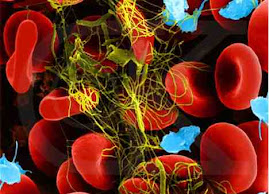Blood clot in leg vein can be deadly
excerpt taken from Contra Costa Times
Q: Nine months ago, our son, 42, had a deep-vein thrombosis. The clot was in the calf and thigh vein. He was given an anticoagulant and the clot was surgically removed, but surgery was only partly successful. Some of the clot remains in his leg veins. He continues to take Coumadin and is told it may take a year for the clot to dissolve. His calf is often swollen and painful. Can you suggest any additional treatment?
A: For readers unfamiliar with this problem, some definitions are necessary. Thrombophlebitis (THROM-boh-flea-BITE-is) is a clot in a vein. "Thrombo" means "clot," and "phlebitis" is vein inflammation. The leg is the common site for it to happen. A person on bed rest after surgery (especially knee and hip surgery), who is sitting for prolonged times during a car or plane trip, taking birth-control pills or suffering trauma is at risk of getting thrombophlebitis.
Clots in the deep veins of the leg, the ones you cannot see, are the dangerous kind. Bits of those clots can break away from the main clot and be carried in the circulation to the lung, where they can plug a lung blood vessel. That's called a pulmonary embolism, and it can be deadly.
Clots in leg veins cause the overlying skin to turn red and become tender. The leg swells and is painful. Ultrasound examination of the veins establishes the diagnosis.
Anticoagulants are the treatment. They don't dissolve the clot, but they keep it from growing larger and they prevent the chance of a pulmonary embolus. In time, a canal burrows through the clot, and blood flow is re-established or blood finds alternate routes to leave the leg. It takes months for this to occur. Nothing speeds the process. Time is the medicine of choice.
A large number of people develop what's called the post-thrombotic syndrome after thrombophlebitis. The leg remains swollen and painful. Compression stockings and frequent leg elevation minimize this complication.
Tuesday, February 19, 2008
Good Information On DVT - Only Taking Coumudin for 1 year
Labels: how long should i take coumodin
Tuesday, February 5, 2008
Coumadin - Forgetting to take coumadin
I have noticed that whenever I forget to take coumadin that I get phantom pains in my leg that the blood clot happened in. Sometimes I get headaches also. I wonder if this has to do with my blood getting thicker???
I have enquired with my doctor about the consequences if I stop taking it and she has told me that it stays in your system for at least three days even though your blood level will gradually get thicker over that time. She smiled and told me that I would feel it if I stopped taking it...
Another nurse told me that one of her patients stopped taking coumadin and kept ending up in the intensive care unit with a heparin bag next to his bed.
These could all be scare tactics to make the drug company who makes coumadin, Bristol-Myers Squibb Company, lots of money. I am very weary of how much influence drug companies have and am always weary of the gift bags I see the drug representatives bring into my doctors office but a little rat poison has never killed anyone right?
My father who had suffered a blood clot that almost killed him, had a doctor that was vehement about him not staying on Bristol-Myers Squibb Companys wonder drug.
All I know is that I can definitely feel some type of twinges of pain in the leg that had the blood clot when I forget to take my coumadin. It usually takes 4 hours but I do feel it.

